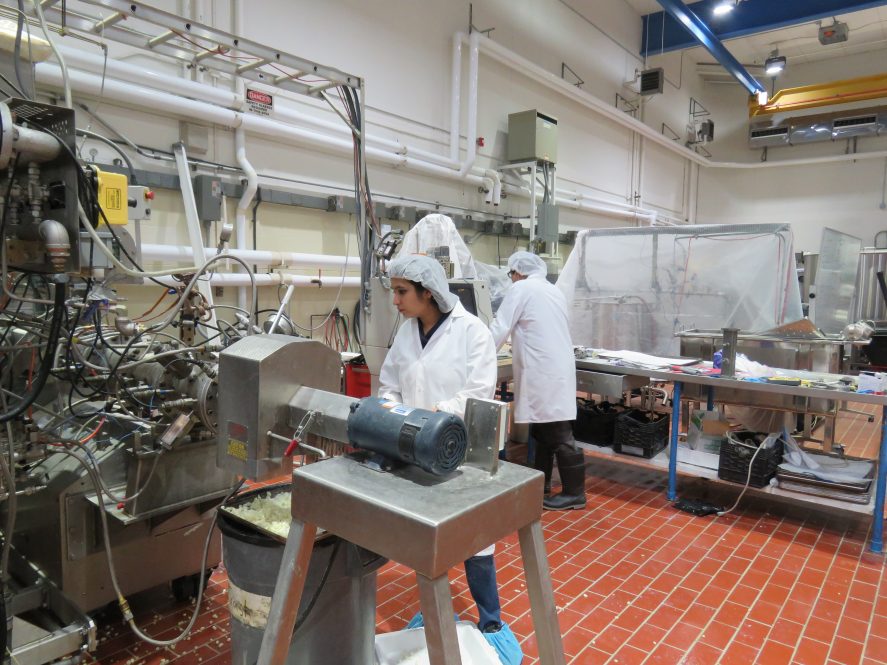Subtracting Additives: Using Extruder Die Design to Create Healthier Processed Foods

In today’s fast-paced world, where more and more people are consuming convenient processed foods. A renewed focus on health is driving demand for processed foods with the nutritional benefits of natural whole foods. In response, food companies are working to harness new ingredients and processes to improve their products.
To help provide healthier processed foods, my research focused on improving the functionality of milk protein concentrate, a nutritious ingredient that possesses many functional properties, such as emulsification, stabilization, foaming, etc. My research shows that, when altered using supercritical fluid extrusion and different extruder die designs, milk protein concentrate can be further improved to be used as a natural, nutritious ingredient in foods.
Consumers Demand Healthier Processed Foods
The consumption of processed and ultra-processed foods is increasing across the world. Between 2002 to 2016, the increase in sales of ultra-processed foods was highest for South and Southeast Asia and North Africa and the Middle East, with increases of 67.3 percent and 57.6 percent, respectively. For ultra-processed drinks, the increase was again highest for South and Southeast Asia at 120 percent, with Africa a distant second at 70.7 percent.
Processed food industries provide consumers with convenient foods such as ready to eat/drink, ready to cook, easy to carry, etc. The preparation of these foods requires additives, either as processing aids or for increased shelf life. During formulation and processing, the industry uses many different additives, such as emulsifiers, stabilizers, foaming agents, antioxidants, and preservatives, to achieve different functionalities. For these reasons, food additives have become indispensable in food processing.
[A] growing population of health-conscious consumers with expanding disposable incomes is fueling the growth of high-quality, convenient foods with natural ingredients.
Organizations such as the USDA and FDA in the United States and the FSSAI in India have standards in place to guide as well as limit the use of such ingredients. Food products are also properly labeled so that consumers are informed about the contents of their food.
Owing to the growing interest in the effect of diet on health, consumers are increasingly demanding foods that are not only convenient but also all-natural and clean label. Consequently, food manufacturers are motivated to find processing techniques to improve the functionality of natural ingredients and reduce their reliance on additives.
Process-Based Functionalization of Natural Ingredients
The use of natural, food-based ingredients to replace additives in processed foods is one way food companies are developing clean-label products. For example, natural colorants can be used instead of their chemical counterparts. This direct replacement has many limitations, however, such as low functionality (a higher amount of a natural ingredient is often required due to lower efficiency), lower storage stability, and poor quality of manufactured products, all of which contribute to reduced consumer acceptability.
Process-based functionalization of food components to remove the need for additives from external sources is another way to manufacture clean-label products. Various technologies are being explored to prepare functional food-based ingredients such as novel extraction technologies and the utilization of bioreactors to harvest bio-ingredients. Extrusion is one such technology that is being increasingly used for the functionalization of food ingredients. One such technology, extrusion, is being used increasingly for the functionalization of food ingredients such as modification of starches to be used as thickening or gelling agents and formation of resistant starch to be used as fiber in food products.
Milk Protein Concentrate as a Functional Ingredient
Milk proteins can perform a wide range of key functions in prepared foods, including emulsification, thickening, gelling, and foaming. Milk protein concentrate (MPC) powders are a nutritionally attractive, high-protein, low-lactose ingredient that contains casein and whey protein in the same ratio as in milk. The incorporation of MPC has been explored in many commercial food products to increase their protein content such as in nutritional beverages and dairy products, geriatric foods, infant formulas, energy bars, frozen desserts, bakery products, etc. In my major research, MPC has been processed as an expanded protein-rich baby food, with a special focus on properties like quick disintegration, smooth mouthfeel, and ease of handling while maintaining its nutritional qualities. Additionally, native milk proteins can be processed by various techniques to alter their structure and improve their functionality. The changes induced in protein structure correspondingly alter their functional characteristics such as emulsification. However, MPC’s poor solubility limits its use in commercial value-added products such as higher amounts of MPC addition may become problematic in beverage formulations.
Yet, a growing population of health-conscious consumers with expanding disposable incomes is fueling the growth of high-quality, convenient foods with natural ingredients. Key strategies to compete in this market space require new approaches for processing to present milk protein as a nutritionally and functionally superior, shelf-stable, sensorially attractive, affordable, and convenient product.
Extrusion Processing
Extrusion processing is one of several approaches that has been used to modify the functional properties of proteins. Conventional extrusion cooking is a high-temperature, short-duration process that has been widely used for several years to manufacture many commercial food products, such as breakfast cereals, snacks, and savory items. However, the high-temperature range (130-160˚C) of traditional steam extrusion can lead to problems with heat-sensitive ingredients like milk proteins. Conventional extrusion of proteins may cause protein aggregation and polymerization at higher processing temperatures, limiting their functionality and negatively affecting their intended use.
In contrast, supercritical fluid extrusion (SCFX) is a hybrid technology that combines the plasticizing and expansion properties of supercritical carbon dioxide to generate microcellular foam from biopolymer feedstock at low temperatures (<100℃), controlled shear, and in a temporarily induced acidic environment. SCFX technology offers attractive options for processing novel dairy-based ingredients while retaining nutritional and organoleptic qualities. In my study in the Rizvi Lab at Cornell University, we use low-shear, low-temperature, and temporarily imposed acidity via high-pressure, carbon dioxide-based, high-moisture extrusion to impart new and improved functionality to MPC.
Extruder Die Design and Protein Functionality
 When MPC is fed through the SCFX machine, it exits at an opening called a die, at which point the high-pressure carbon dioxide mixed into the protein expands, causing it to puff up. The shape and dimensions of the die determine the flow profile and alter the wall shear significantly, resulting in products with different functionalities.
When MPC is fed through the SCFX machine, it exits at an opening called a die, at which point the high-pressure carbon dioxide mixed into the protein expands, causing it to puff up. The shape and dimensions of the die determine the flow profile and alter the wall shear significantly, resulting in products with different functionalities.
We used three die shapes—circular, annular, and slit—to evaluate their effect on protein functionality. The circular die generates an elongated parabolic flow distribution whereas the slit die exhibits a blunt parabolic flow across the width of the die.
Different flow profiles of the extruder melt result in different shear experiences by the material, contributing to altered extrudate properties. For example, longer dies are more suitable for protein texturization as they promote the cross-linking of proteins and provide cooling time, thereby limiting expansion at the die exit. Due to the increased die residence times, longer dies result in increased collisions among the molecules promoting interactions. However, a very high shear rate through the die may disrupt linkages and impair protein functionality. Thus, changing the shape of the extruder die while holding other parameters constant can result in extrudates with different functional properties.
Our observations demonstrate that extrudates from dies with higher wall shear showed greater protein extractability, surface hydrophobicity, and water solubility, suggesting a significant breakdown of protein aggregates (formed in the extruder barrel prior to the die). The breakdown of protein aggregates contributes to the improved solubility, viscosity, and gelling ability of protein solutions, indicating their potential to be used as a natural food additive. This study reasonably establishes that die design can be successfully exploited to impart different functional properties to extrudates like MPC. When coupled with low-temperature, low-shear supercritical extrusion, functional properties can be imparted to heat-sensitive ingredients such as milk protein concentrates.
A Better Additive
The findings of this study could have significant utility in designing novel milk protein-based ingredients to be used as food additives for health-conscious consumers seeking nutritionally superior and safer foods. Other research from our lab has found that the functionalization of MPC via SCFX produces a new ingredient that is able to form stable emulsions at room temperature. Emulsions stabilized with functionalized MPC demonstrate improved emulsion capacity, viscosity, and stability. The utilization of different dies during extrusion can result in different degrees of protein interactions and can produce a range of ingredients with targeted functionalities. Therefore, SCFX functionalized MPC can provide an opportunity for utilization as a natural additive in processed foods and the application of different die designs during SCFX processing can aid in the generation of a range of MPC-based additives.
TCI Scholar Bindvi Arora is a PhD candidate in the field of food science.





